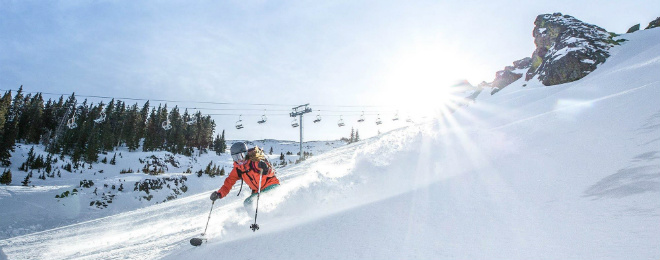Taos Ski Area
Taos Ski Valley is set in a north-facing bowl in the Carson National Forest and is known for its expert terrain. “You don’t have to be an expert to ski Taos, but there is no better place to become one,” is how the resort pitches its appeal—and the steep powder snow certainly favors advanced skiers. However, there are some nice novice slopes and the ski school, located at a base elevation of 9,207 feet (2,806 m), has been rated Number One several times by various ski magazines, so there is scope for beginners.
The highest point is Kachina Peak at 12,481 feet (3,804 m). Kachina Peak abutts the Wheeler Wilderness Area home to Mt. Wheeler – the highest peak in New Mexico. The addition of a new lift up to Kachina Peak brings Taos Ski Valley’s vertical drop up to an impressive 3,274 feet (998 m). But the skiing is not about vertical feet to be skied, rather it’s all about demanding advanced trails and testing yourself, possibly on an extreme trail down from the elongated ridge summit.
Indeed, the ski valley is dominated by a line of ridges from Kachina Peak along Highline Ridge onto West Basin Ridge and curving out into Wonder Bowl. The ski area encompasses 1,294 acres (524 ha) with 110 trails -24% beginner, 25% intermediate and 51% advanced/expert. The Out to Launch Terrain Park is a new addition, located on Maxie’s trail under lift No.7, offering two huge airs, a hip, a quarter pipe, and rails. The park is groomed nightly.
It is worth noting that hiking is certainly part of the culture at Taos and much of the best expert terrain is accessible only after a short hike. If visiting, expect to do a little hiking. Many short, 5-minute hikes bring Taos’ best steeps into reach.
One thing to be aware of: snowfall is not reliable especially early season (the resort opens November 28th and closes the first Sunday in April). It’s fair to say that snowfall fluctuations at Taos can be extreme. While Taos averages 305 inches (775 cm) of snowfall annually, in bad winters Taos has seen as little as 140 inches (355 cm). Booking a trip earlier than February can be risky. That said artificial snowmaking facilities cover 100 percent of the beginner and intermediate trails. The weather does fluctuate with the coldest month always being January, while March temperatures can nudge over 50 ˚F at the base.











